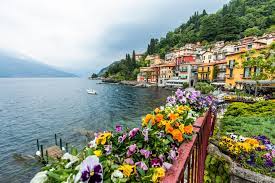Italy: A guide to the amazing Lake Como

Everett Potter
Rome: Several times a year, I’m fortunate enough to cruise up and down the deep waters of Italy’s mountain-fringed Lake Como. I have explored the tourist sights and lesser-known villages, the stately streets of the city of Como, and the hamlets with breathtaking views that will never make it into a guidebook. Lake Como is one of those dreamy places that exceeds expectations, a veritable operatic stage set of villas, garden follies, ferries and speedboats on a 29-mile-long body of water that resembles a fjord more than a lake.
If Lake Como were nothing more than a gorgeous lake in Northern Italy, it would still be one of the country’s star attractions. The lake has one of the most dramatic settings in the world, a inverted “Y” flanked by steep, thickly wooded mountainsides. To the north lie the Alps, which are snow-dusted for much of the year, while along the lakeshore are palm trees next to ornate villas that, in some cases, have origins as far back as the 16th century.
But Lake Como’s name has become much more potent in the 21st century, a catchphrase that automatically connotes glamor and wealth. Part of that is due to the proximity of Milan, less than an hour away, and the patronage of the fashion crowd. But much of the buzz is because of George Clooney, who bought a lakeside villa here nearly two decades ago. He brought his Hollywood panache and pals along, such as Brad Pitt, Julia Roberts, and Matt Damon, who enhanced the glamor and myth of the lake with their comings and goings. But truth be told, Como’s history long predates the latest iteration of an LA bro-pack.
Celtic tribes once lived along these shores until the Romans drove them away, and Julius Caesar ordered 5,000 of his men to drain the swamp at the end of the lake and set up the first Roman city at the city of Como. In time, the wealthy Lombards of nearby Milan came in the 16th century, finding a location where imported Chinese silkworms thrived on the lake’s native mulberry trees. They built fortunes based on their silk empire, and the industry thrives today, as Versace, Hermes, Ralph Lauren, and countless others continue to source their silk here.
By signing up, you accept and agree to our Terms of Service (including the class action waiver and arbitration provisions), and you acknowledge our Privacy Statement.
The wealthy Milanese merchants built villas, and then, in the fashion of the day, they became patrons of the arts. You can’t visit Como without hearing cultural name-dropping: how Leonardo painted here, how Verdi composed part of La Traviata there, how Bellini worked on his opera Norma, and how writers as diverse as Wordsworth, Longfellow, and Hesse wrote poetry extolling the lake’s singular virtues.
I’ve spent time on Lake Como for years. Every season is distinct, and I see things I did not see before every time I visit. What is the perfect time to go? I like early summer when the high mountain snow and a fringe of white on the peaks to the north still feed waterfalls.
Regardless of the season, the perfect day on Lake Como is spent on the water, looking at the villas, stopping at those that can be visited, having lunch, and swimming. If your budget allows, the boat trip should be in a sleek wooden Riva speedboat heading up the lake to meet friends in Lenno, or the more touristed Varenna, where a jumble of ochre-colored buildings is the backdrop for café life and the slow sipping of prosecco. For those who don’t have access to a private boat, the ferry system will do, as it crisscrosses that lake and provides access to the bustling waterfront and narrow shop-filled lanes of Bellagio. It allows you to explore quiet fishing villages such as Pescallo. It drops you at Tremezzo to explore the gardens and artwork at one of the lake’s masterpieces, Villa Carlotta, a favorite of 19th-century writers Edith Wharton and Henry James.
Indeed, as you travel the lake, many grand private villas have names to match. Villa Fontanelle in Moltrasio, once owned by Gianni Versace, was sold after his death to Arkady Noviko, arguably Russia’s most successful restaurateur and a man known colloquially as the “Blini King.” You can observe it from the water, as you can Villa le Rose, where Churchill retreated post World War II. Laglio is where Clooney and his wife Amal live, at Villa Oleandra, and Villa La Cassinella has long been rumored to be owned by Sir Richard Branson, who denies it.
Then there is Villa Balbienello, my favorite, which holds the most coveted place on the lake, a promontory close to the village of Lenno, topped by a fantastic stone compound. At its roots, the building was a monastery acquired by private hands. It eventually became the home of Guido Manzino, heir to an Italian supermarket fortune and a self-styled explorer who led the first Italian expedition up Mt. Everest. It’s a museum now, and thankfully, Monzino’s quirky and sometimes wondrous collections of his trips to the four corners of the earth are still housed here in what must be the most photographed villa on the lake. Filmmakers adore the place. Here, Casino Royale was shot, A Month by the Lake, and even Star Wars II: Attack of the Clones. It can get very crowded here, so go early in the morning and soak in the gardens, the sculpture, and the sheer elegance of the place.
Villa Melzi is a 10-minute stroll from the busy docks at Bellagio, where silk-mad shoppers and lunch-going day trippers can make it a little too crowded. At Villa Melzi, you can stroll acres of lakeside gardens planted with specimen trees from around the globe. Alas, the interior of the villa, built for Francesco Melzi d’Eril, vice president of the Italian Republic, and where Franz Liszt composed his Dante Symphony, is private. The grounds, however, give you a real sense of tranquility and what Lake Como must have been like 150 years ago.
The best part of Lake Como is the chance to sleep and stay in one of these historic villas. A few years ago, the Grand Hotel Tremezzo, built in 1910, was redone from top to bottom, infusing serious chic into an aging dowager. The lakeside champagne bar and the pool that floats in Lake Como are the essence of lakeside glamor. The same owners restored Villa Passalaqua down the lake in Moltrasio, making a hotel out of this lakeside villa where Napoleon stayed and Bellini composed.
Villa d’Este in Cernobbio continues to reign as the queen of the lake, originating in the 16th century as a residence for a Cardinal before passing to the hands of British royalty and eventually becoming a hotel in the late 19th century.
But the stakes have gotten even higher in the past couple of years. Il Serena di Lago opened in Torno, while the Vista Palazzo, an 18-room luxury lair in the city of Como, opened in 2018, as did the six-suite Villa Lario set on two lakeside acres in Pognana Lario. One of the newer entries to the Lake Como luxe sweepstakes is Mandarin Oriental, which took over a villa in Blevio.
You can dine regally at some of these hotels, but I prefer the local spots. A couple of months ago, it was a quiet café in Cernobbio, Osteria del Beuc, where I sat at alfresco table 50 feet from the lake on a sultry night and drank the local white wine blend from the producer Sorsasso, situated above the lakeside village of Domasso, the exact wine that Clooney requested to be served at his wedding to Amal. It accompanied a lemon and parmesan risotto served with a dramatic scoop of basil-flavored gelato in the middle, slowly melting into the risotto. It was tradition married to the fashionable, a surprise and a revelation, a little like Lake Como.





